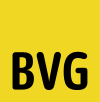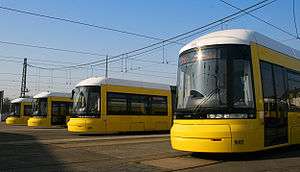Berliner Verkehrsbetriebe
 | |
| state | |
| Founded | 1928 |
| Headquarters | Berlin, Germany |
Area served | Berlin |
Key people | Sigrid Evelyn Nikutta (CEO) |
| Services | Public replacement transport |
| Owner | State of Berlin (100%) |
Number of employees | 11,526 |
| Website | http://www.bvg.de/ |
The Berliner Verkehrsbetriebe (German for Berlin Transport Company) is the main public transport company of Berlin, the capital city of Germany. It manages the city's U-Bahn underground railway, tram, bus, replacement services (EV) and ferry networks, but not the S-Bahn urban rail system.
The generally used abbreviation, BVG, has been retained from the company's original name, Berliner Verkehrs Aktiengesellschaft (Berlin Transport Corporation). Subsequently, the company was renamed Berliner Verkehrs-Betriebe. During the division of Berlin, the BVG was split between BVG (Berliner Verkehrsbetriebe Gesellschaft - West Berlin) and BVB (Berliner Verkehrsbetriebe - East Berlin), also known as the Volkseigenes Kombinat Berliner Verkehrsbetriebe (BVB). After reunification, the current formal name was adopted.
History


The Berliner Verkehrs Aktiengesellschaft was formed in 1928, by the merger of the Allgemeine Berliner Omnibus AG (the operator of the city's buses), the Gesellschaft für Elektrische Hoch- und Untergrundbahnen (the operator of the U-Bahn) and the Berliner Straßenbahn-Betriebs-GmbH (the operator of the city's trams). On 1 January 1938, the company was renamed Berliner Verkehrs-Betriebe, but the acronym BVG was retained.[1]
From 1 August 1949, the BVG networks in West Berlin and East Berlin were operated separately. The two operators were originally known as BVG (West) and BVG (Ost), but from 1 January 1969 the eastern operator was renamed as the Kombinat Berliner Verkehrsbetriebe or BVB. After the reunification of Berlin, the two operators were recombined into the Berliner Verkehrsbetriebe on 1 January 1992.
Prior to the division of Berlin, tram lines existed throughout the city, but BVG (West) abandoned all the tram lines in its part of the city, replacing them all by buses by 1967. However BVG (Ost) retained its tram lines, and on the reunification of Berlin the BVG inherited a considerable network of routes in the eastern half of Berlin.
On 9 January 1984, BVG (West) took over the responsibility for operation of the S-Bahn services in West Berlin. This urban rail network had previously been operated in both halves of Berlin by the Deutsche Reichsbahn, the state rail operator of East Germany, but had been subject to a boycott in the west after the building of the Berlin Wall. With the reunification of Berlin, responsibility for the S-Bahn reverted to Deutsche Bahn AG (DBAG), the state rail operator of Germany. The S-Bahn is currently managed by the S-Bahn Berlin GmbH, a subsidiary company of DBAG.[2]
BVG (West) also took part in the Berlin M-Bahn project, an urban maglev system, in the period between 1984 and 1992. The project used a section of the U-Bahn right of way that was out of service due to the building of the Berlin Wall, and was dropped with the fall of that wall.[3]
The BVG launched the MetroNetz on 12 December 2004 which remodeled the tram and bus network to create 24 tram and bus lines (with M prefix) covering parts of the city that weren't served by S-Bahn or U-Bahn.
Chief executive officers
| Name | From | To |
|---|---|---|
| Fritz Brolat | 1929 | 1931 |
| Ernst Lüdtke | 1929 | 1933 |
| Wilhelm Majerczik | 1929 | 1930 |
| Gotthard Quarg | 1929 | 1933 |
| Hermann Zangemeister | 1929 | 1933 |
| Wilhelm Bennighoff | 1933 | 1938 |
| Georg Thomas | 1933 | 1934 |
| Max Reschke | 1934 | 1937 |
| Alfred Lorenz | 1935 | 1938 |
| Otto Ulmer (Landrat) | 1937 | 1945 |
| Max Mroß | 1939 | 1945 |
| Franz Fink | 1939 | 1945 |
| Walter Schneider | 1945 | 1963 |
| Wilhelm Knapp | 1945 | 1949 (Went to BVG-Ost) |
| Walter Struwe | 1945 | 1970 |
| Johannes Warnke | 1945 | 1960 |
| Fritz Neubecker | 1947 | 1968 |
| Richard Timm | 1952 | 1958 |
| Karl König | 1960 | 1965 |
| Heinz Goltz | 1971 | 1975 |
| Joachim Piefke „Der Mann mit der Fliege“ |
1971 | 1986 |
| Bruno Frank | 1972 | 1982 |
| Hans-Erhardt von Knoblauch | 1977 | 1986 |
| Willi Diedrich | 1980 | 1988 |
| Harro Sachße | 1983 | 1994 |
| Helmut Döpfer | 1986 | |
| Konrad Lorenzen | 1988 | 1994 |
| Rüdiger vorm Walde | 1994 | 2001 |
| Andreas Graf von Arnim | 2002 | 2005 |
| Andreas Sturmowski | 2005 | 2010 |
| Sigrid Evelyn Nikutta | 2010 | |
Operations
.jpg)

.jpg)
U-Bahn
BVG operates the U-Bahn, an urban rapid transit rail system. The U-Bahn now comprises nine lines with 173 stations and a total length of 147 kilometres (91.3 mi). Trains run every two to five minutes during peak hours, every five minutes for the rest of the day and every ten minutes in the evening and on Sunday.[4][5]
U-Bahn service is provided by 1266 carriages, of which 500 are used on the earlier small-profile lines (U1 to U4) and 766 are used on the later large-profile lines. These cars travel 132 million km (83 million mi), carrying 400 million passengers, over the year.[4][5]
Trams
BVG operates a tram network comprising 22 tram lines with 377 stops and measuring 293.78 kilometres (182.55 mi) in length. Of these, nine are designated as part of the MetroNetz, which provide a high frequency service in areas poorly served by the U-Bahn and S-Bahn. These MetroTram tram lines are recognisable by an M prefix to their route number, and are the only tram routes to operate 24 hours a day.[5]
Tram service is provided by 391 carriages, of which 154 are modern low floor carriages and 237 are older carriages. Virtually all of the remaining network is within the confines of the former East Berlin, as all the routes in the former West Berlin were abandoned during the period of the city's partition. However, there have been some extensions of routes across the former border since reunification, most remarkably to the city’s new main railway station Berlin Hauptbahnhof (lines M5, M8 and M10).[5]
Buses
BVG operates a network of 149 daytime bus routes serving 2634 stops and a total route length of 1,675 kilometres (1,041 mi), together with a night bus network of 63 bus routes serving 1508 stops and a total route length of 795 kilometres (494 mi). Seventeen of BVG's bus routes are designated as part of the MetroNetz, which provides a high frequency service in areas poorly served by the U-Bahn and S-Bahn. Like the MetroTram tram routes, these MetroBus routes can be recognised by an M prefix to their route number. A further 13 BVG-operated bus routes are express routes with an X prefix to their route number.[5]
BVG bus service is provided by a fleet of 1349 buses, of which no fewer than 407 are double-decker buses. Whilst such buses are common in Ireland and the United Kingdom, their use elsewhere in Europe is extremely uncommon.[5]
Route 218 is partially operated by ex-BVG vintage vehicles now in preservation but used in revenue-earning service. The services depart from Theodor-Heuss Platz every two hours from 11:15 to 19:15 and return from Pfaueninsel from 10:00 to 20:00.
Ferries
Berlin has an extensive network of waterways within its city boundaries, including the Havel, Spree and Dahme rivers, and many linked lakes and canals. These are crossed by six passenger ferry routes that are operated by the BVG.[6]
Fares
The BVG is a member of the Verkehrsverbund Berlin-Brandenburg (VBB), the transport association run by public transport providers in the German states of Berlin and Brandenburg. This body provides a common fare structure that allows travel on various operators in and around Berlin.
All BVG services form part of the VBB's common public transport fare structure. This covers the city of Berlin and approximately 15 kilometres (9.3 mi) beyond the city boundaries. The area is split into three zones. Zone A is the central parts of the city (inside the Ringbahn), and zone B is the outer parts of Berlin City. Zone C covers an area beyond the city boundaries. Ticket fares have a slight price difference between these three zones. For instance in June 2010, a one-day ticket for zone A+B was priced at €6.10, a zone B+C one-day travel ticket was €6.30, and for all three zones A+B+C, the price was €6.50.[7][8]
See also
References
- ↑ "Die Geschichte der Berliner Verkehrsbetriebe" [The history of the Berlin public transport] (in German). BVG. Retrieved 23 June 2010.
- ↑ Hardy, Brian (2000). The Berlin S-Bahn Handbook. Capital Transport Publishing. ISBN 1-85414-185-6.
- ↑ Hardy, Brian (1996). The Berlin U-Bahn. Capital Transport Publishing. ISBN 1-85414-184-8.
- 1 2 "The Berlin metro (U-Bahn)". Means of Transport & Routes. BVG. Archived from the original on 20 August 2007. Retrieved 6 September 2007.
- 1 2 3 4 5 6 "BVG in Zahlen" [BVG in figures] (in German). BVG. 31 December 2009. Retrieved 16 June 2010.
- ↑ "Linien, Netze & Karten – Verkehrsmittel & Linien – Fähre" (in German). BVG. Retrieved 14 June 2010.
- ↑ "Tickets / Ticket fares". Verkehrsverbund Berlin-Brandenburg. Retrieved 15 June 2010.
- ↑ "Tickets & Tarife" [Tickets & Fares] (in German). BVG. Retrieved 16 June 2010.
External links
![]() Media related to Berliner Verkehrsbetriebe at Wikimedia Commons
Media related to Berliner Verkehrsbetriebe at Wikimedia Commons
Coordinates: 52°29′31″N 13°21′35″E / 52.49194°N 13.35972°E
